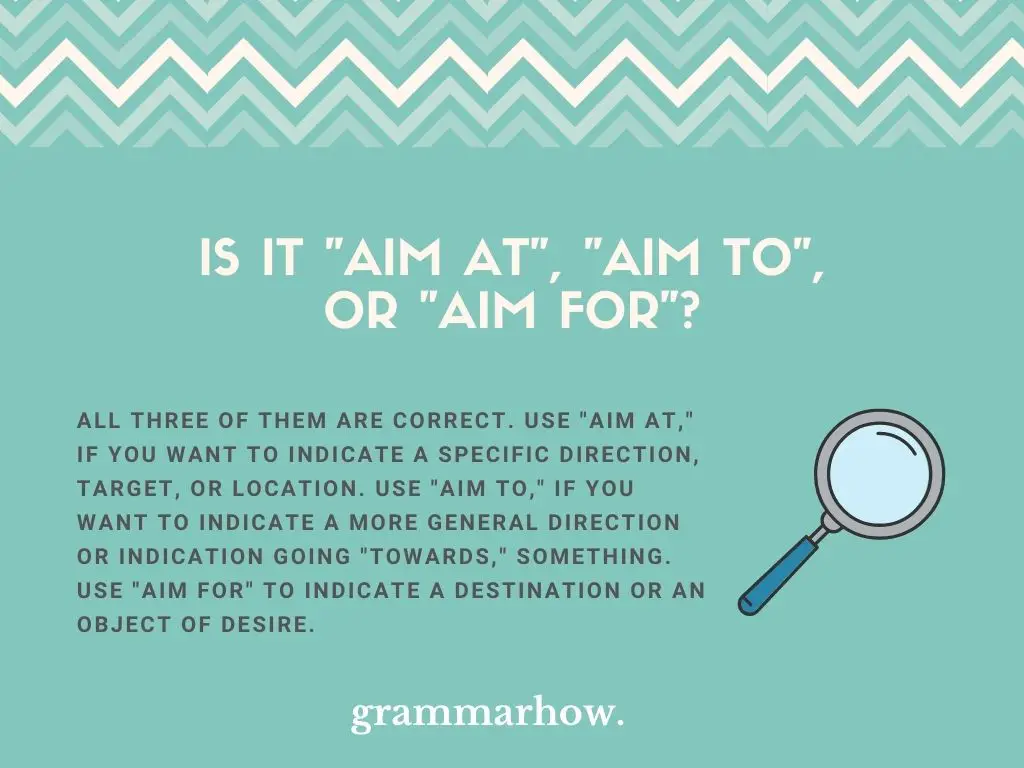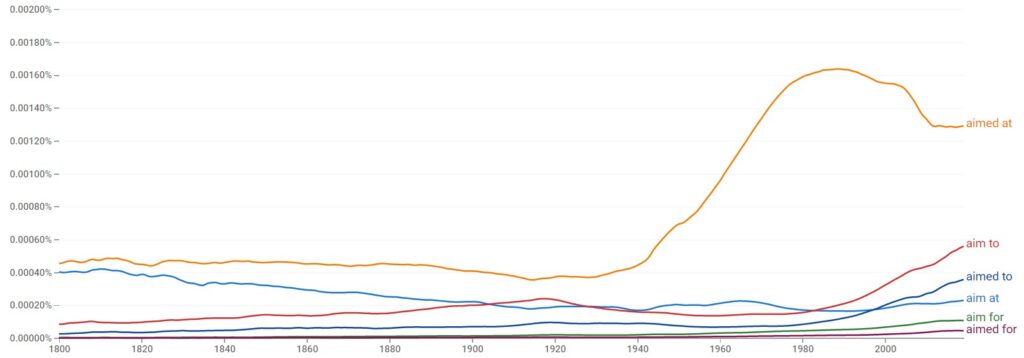The phrases “aim at,” “aim to,” and “aim for” are all found used frequently in the English Language, but you may wonder if they can be used interchangeably. Here you will learn the proper context in which to use each of the prepositions with the word “aim.”
Is It “Aim At”, “Aim To”, Or “Aim For”?
All three of them are correct. Use “aim at,” if you want to indicate a specific direction, target, or location. Use “aim to,” if you want to indicate a more general direction or indication going “towards,” something. Use “aim for” to indicate a destination or an object of desire.

You can see from the explanation above that they are all quite similar, but if you use the prepositions according to their specific definitions, it changes the meaning of the phrase ever so slightly.
The preposition “at” indicates near the position of, toward the specific direction of, or near the location of something. It is more precise.
The preposition “to” indicates “towards” or “reaching as far as,” so it is more generalized.
The preposition “for’ indicates a purpose, desire, or destination. It is mostly used to indicate something that has not yet been completed or achieved.
However, you will often see the three phrases used interchangeably in casual language, especially the phrases “aim at” and “aim to,” because their meanings are so similar.
Should I Use “Aim” Or “Aimed”?
You should use “aim” if you are talking about pointing or directing something in the future or at the present time. Use the word “aimed” to indicate that the “aiming” has already happened and is now in the past.
You can see from this Google Ngram Viewer, that of all the versions both present tense and past tense, the phrase “aimed at” is the more frequently used one. This fact is particularly true in the modern-day English Language.

What Does “Aimed At” Mean?
The phrase “aimed at” means that you pointed or directed something and someone or something and that the action of doing the pointing or directing occurred sometime in the past and has been completed.
Let’s look at some examples for a further clarification of how “aimed at” is used in a sentence.
- The marksman aimed at the target during shooting practice yesterday and hit it every time.
- Each one of us aimed at the basketball hoop the best we could while playing the other day, but still couldn’t seem to make many shots in the hoop.
- He aimed at the first baseman’s glove when he threw the ball, but despite the good throw, the first baseman didn’t catch it.
See how in each of these examples, the action of “aiming” has already been completed.
What Does “Aim To” Mean?
If you say “aim to” it means that you want to indicate that you are moving towards something (i.e., a goal), you want to direct a person or object to a general area, rather than a specific area or target, or you plan to do something.
This phrase is used in present or future tense and indicates that the “aiming” is happening right now or will happen in the future. Look at these sentences for some examples.
- Every day when I go to work, I am to be the best teacher that I can be and make my students proud.
- Elliot knows that each day he should aim to please his parents and show them proper respect.
- We aim to have the new product line ready for production by the end of the month.
- I always aim to follow the example of my older sister because I admire her so much.
- If you aim to the left next time you might have a better chance of scoring a goal.
Notice how in these examples the direction is more generalized, the person is moving towards a goal or plans to do something. All of the sentences are also taking place currently (1st, 2nd, and 4th examples) or will take place in the future (3rd and 5th examples).
What Does “Aim For” Mean?
Use “aim for” when you want to put your energy towards a specific goal, accomplishment, object, or desire. You can also use it to specify a general destination of an object.
This phrase usually indicates something that will occur soon or further in the future as you can see from the examples that we show here.
- I’m looking to aim for August for the family reunion, but I need to check with everyone’s vacation schedules first.
- Over the next year, the company wants to aim for less packaging in their products as a way to reduce unnecessary waste.
- Make sure that you try to aim for the target before you shoot the bow and arrow.
- His snowball has an aim for you! Make sure you try to dodge it!
Can “Aim” Be Used With Other Prepositions?
You can use the word “aim” with several other prepositions and have it be grammatically correct. The most common other prepositions that you can use with the word “aim” include “below,” “behind,” “inside,” “outside,” “down,” “beyond,” and “near.”
Let’s look at an example of the word “aim” used with each of these different prepositions.
- Sometimes you want to aim below your target when shooting to counteract the effects of gravity.
- The aim of the project was to inform people about the difficulties many early settlers faced when coming to America.
- When playing pool, make sure you aim inside of the pocket so that the ball will reach it.
- When pitching the game of baseball, you should not try to aim outside the batter’s strike zone as it could cost you a ball.
- As you wash the car with the hose, make sure you aim down so that you don’t spray everyone else around you.
- If you really want to succeed at something, try to aim beyond the initial goals that you set and challenge yourself in the process.
- If you’re looking for a good place to set up, aim near that area by the tree because it is shady.
You may also occasionally see the word “aim” used with other prepositions as well.

Martin holds a Master’s degree in Finance and International Business. He has six years of experience in professional communication with clients, executives, and colleagues. Furthermore, he has teaching experience from Aarhus University. Martin has been featured as an expert in communication and teaching on Forbes and Shopify. Read more about Martin here.
